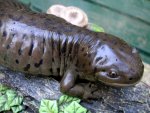zonbonzovi
New member
- Joined
- Nov 10, 2008
- Messages
- 14
- Reaction score
- 2
- Points
- 0
- Location
- Quagmire, Mars
- Country
- United States
- Display Name
- zonbonzovi
So...I am about to come into possession of an long term captive adult, male, terrestrial D. aterrimus. After copious amounts of habitat research, reading through the boards, etc., etc. I think I have its captive needs covered. However, and in my experience w/ various creatures, there are always details that rear their heads later. Anyone out their keeping this species or other Dicamptodon species that have come across any pecularities that weren't apparent in their initial research?


